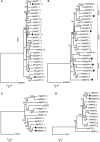Coding-Sequence Identification and Transcriptional Profiling of Nine AMTs and Four NRTs From Tobacco Revealed Their Differential Regulation by Developmental Stages, Nitrogen Nutrition, and Photoperiod
- PMID: 29563921
- PMCID: PMC5850829
- DOI: 10.3389/fpls.2018.00210
Coding-Sequence Identification and Transcriptional Profiling of Nine AMTs and Four NRTs From Tobacco Revealed Their Differential Regulation by Developmental Stages, Nitrogen Nutrition, and Photoperiod
Abstract
Although many members encoding different ammonium- and nitrate-transporters (AMTs, NRTs) were identified and functionally characterized from several plant species, little is known about molecular components for [Formula: see text]- and [Formula: see text] acquisition/transport in tobacco, which is often used as a plant model for biological studies besides its agricultural and industrial interest. We reported here the first molecular identification in tobacco (Nicotiana tabacum) of nine AMTs and four NRTs, which are respectively divided into four (AMT1/2/3/4) and two (NRT1/2) clusters and whose functionalities were preliminarily evidenced by heterologous functional-complementation in yeast or Arabidopsis. Tissue-specific transcriptional profiling by qPCR revealed that NtAMT1.1/NRT1.1 mRNA occurred widely in leaves, flower organs and roots; only NtAMT1.1/1.3/2.1NRT1.2/2.2 were strongly transcribed in the aged leaves, implying their dominant roles in N-remobilization from source/senescent tissues. N-dependent expression analysis showed a marked upregulation of NtAMT1.1 in the roots by N-starvation and resupply with N including [Formula: see text], suggesting a predominant action of NtAMT1.1 in [Formula: see text] uptake/transport whenever required. The obvious leaf-expression of other NtAMTs e.g., AMT1.2 responsive to N indicates a major place, where they may play transport roles associated with plant N-status and ([Formula: see text]-)N movement within aerial-parts. The preferentially root-specific transcription of NtNRT1.1/1.2/2.1 responsive to N argues their importance for root [Formula: see text] uptake and even sensing in root systems. Moreover, of all NtAMTs/NRTs, only NtAMT1.1/NRT1.1/1.2 showed their root-expression alteration in a typical diurnal-oscillation pattern, reflecting likely their significant roles in root N-acquisition regulated by internal N-demand influenced by diurnal-dependent assimilation and translocation of carbohydrates from shoots. This suggestion could be supported at least in part by sucrose- and MSX-affected transcriptional-regulation of NtNRT1.1/1.2. Thus, present data provide valuable molecular bases for the existence of AMTs/NRTs in tobacco, promoting a deeper understanding of their biological functions.
Keywords: AMT and NRT; ammonium; gene expression regulation; heterologous complementation; nitrate; nitrogen and carbon balance; tobacco.
Figures






Similar articles
-
Molecular identification of tobacco NtAMT1.3 that mediated ammonium root-influx with high affinity and improved plant growth on ammonium when overexpressed in Arabidopsis and tobacco.Plant Sci. 2017 Nov;264:102-111. doi: 10.1016/j.plantsci.2017.09.001. Epub 2017 Sep 12. Plant Sci. 2017. PMID: 28969790
-
Molecular identification and physiological functional analysis of NtNRT1.1B that mediated nitrate long-distance transport and improved plant growth when overexpressed in tobacco.Front Plant Sci. 2023 Feb 28;14:1078978. doi: 10.3389/fpls.2023.1078978. eCollection 2023. Front Plant Sci. 2023. PMID: 36925751 Free PMC article.
-
A Critical Role of AMT2;1 in Root-To-Shoot Translocation of Ammonium in Arabidopsis.Mol Plant. 2017 Nov 6;10(11):1449-1460. doi: 10.1016/j.molp.2017.10.001. Epub 2017 Oct 13. Mol Plant. 2017. PMID: 29032248
-
Function and Regulation of Ammonium Transporters in Plants.Int J Mol Sci. 2020 May 18;21(10):3557. doi: 10.3390/ijms21103557. Int J Mol Sci. 2020. PMID: 32443561 Free PMC article. Review.
-
The molecular physiology of ammonium uptake and retrieval.Curr Opin Plant Biol. 2000 Jun;3(3):254-61. Curr Opin Plant Biol. 2000. PMID: 10837267 Review.
Cited by
-
Genome-Wide Identification and Characterization of Ammonium Transporter (AMT) Genes in Rapeseed (Brassica napus L.).Genes (Basel). 2023 Mar 6;14(3):658. doi: 10.3390/genes14030658. Genes (Basel). 2023. PMID: 36980930 Free PMC article.
-
Integrated analyses of ionomics, phytohormone profiles, transcriptomics, and metabolomics reveal a pivotal role of carbon-nano sol in promoting the growth of tobacco plants.BMC Plant Biol. 2024 May 30;24(1):473. doi: 10.1186/s12870-024-05195-1. BMC Plant Biol. 2024. PMID: 38811869 Free PMC article.
-
Ammonium Uptake, Mediated by Ammonium Transporters, Mitigates Manganese Toxicity in Duckweed, Spirodela polyrhiza.Plants (Basel). 2023 Jan 3;12(1):208. doi: 10.3390/plants12010208. Plants (Basel). 2023. PMID: 36616338 Free PMC article.
-
Nitrogen application and differences in leaf number retained after topping affect the tobacco (Nicotiana tabacum) transcriptome and metabolome.BMC Plant Biol. 2022 Jan 19;22(1):38. doi: 10.1186/s12870-022-03426-x. BMC Plant Biol. 2022. PMID: 35045826 Free PMC article.
-
MaCDSP32 From Mulberry Enhances Resilience Post-drought by Regulating Antioxidant Activity and the Osmotic Content in Transgenic Tobacco.Front Plant Sci. 2020 Apr 16;11:419. doi: 10.3389/fpls.2020.00419. eCollection 2020. Front Plant Sci. 2020. PMID: 32373141 Free PMC article.
References
LinkOut - more resources
Full Text Sources
Other Literature Sources

